According to historical records (and urban Myths) there is a wood burning steam locomotive from the mid 1800s buried in the sealed up portion of the Atlantic Avenue Tunnel. It was not uncommon for obsolete technology (old trains, cars, etc) to used for fill in the 19th and early part of the 20th centuries. We hope to excavate the sealed up portion of Atlantic Avenue Tunnel and unearth the buried steam locomotive buried there (according to historical records). There is some information regarding buried steam locomotives found elsewhere in the US.
|
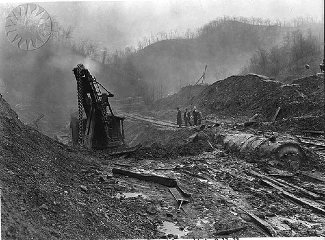
Pic of Steam Shovel & Halfway Buried Locomotive
|
- Buried Locomotive Discovered Beneath City Street (NC)
- The Curious Case of the Buried Locomotives—or Railroad Archeology with a Vengeance (AK) (PDF)
- Richmond’s Buried Train: The Death and Possible Resurrection of Church Hill Tunnel’s Locomotive 231 ( VA)
|
|
|
Found- Buried Steam Locomotive! – Who Says Steam Locomotives Aren’t Buried Under The
Street? In 1994, a circa 1879 Forney steam locomotive from New York City’s Elevated Railway lines was found buried under a Garysburg North Carolina street. At the time, it was reported by the A.P. wire service. As the old proverb goes “one picture is worth 10,000 words”. We have several.Rather than a 56 foot long engine, as stated in the A.P. article, we thinks its possibly a pair of 24 foot long NYC Elevated Railway “Forneys”, as described below. The following is some research done by friend of ours (Richard Fleischer), on the engine(s) buried under a North Carolina street. Likely, these locomotives
are originally from New York City:”By tracing the Rhode Island Locomotive Works construction number 750 I was able to find it was an 0-4-4T Forney type built in March 1879 for the New York Elevated Railroad where it was number 119. This D
class engine had 10×16 cylinders, 42 inch drivers and weighed 37900 pounds. If it is correctly identified it could hardly be 56 feet long as was reported by the newspaper; those elevated engines were about 25
feet long. In July 1896 #119 was rebuilt to class D-2. Electrification of the elevated lines made hundreds of steam elevated engines surplus. The well made engines with years of life left in them were sold to contractors for road building and for industrial use. Number 119 was sold in December 1904 to the Conway Lumber
Co. of Conway, North Carolina. So it was not used on the Atlantic Coast Line.”
And the plot thickens…Whats Really Buried Under Atlantic Avenue? The following pictures were kindly provided by the North Carolina Department of Transportation Archeology Group. |
|
|
|
|
|
|
|
|
|
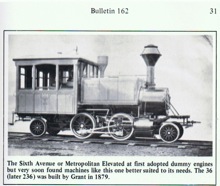 |
As can be easily seen from this photo, New York Elevated Forney locomotive
bodies had quite a large surface area comprised of flat metal plate.
Both the cabs and water tanks were made of flat plate. We submit this
is what’s clearly evident in the excavation site photos taken by the
North Carolina DOT Archeology Group. An engine of this particular “pre
Forney” type (Class H), the # 45, was sold to the Cliffside Lumber Co.,
of Cliffside, NC- about 200 miles from Garysburg, NC.
|
|
|
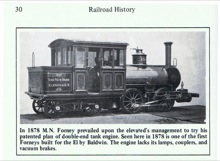 |
In the next photo, we see a Forney likely similar to the # 119, which was sold to the Conway
Lumber Co., of Conway, NC- a scant 20 miles from the Garysburg
excavation site. These appear to be the locomotives excavated by
the North Carolina DOT Archeology Group at Garysburg, NC back in 1994 |
|
|
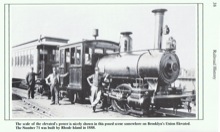 |
To give the Forney engine
physical size some spatial reference, the following photo shows
Forney # 71 on the Brooklyn Union Elevated line. Note the garb of the
engineer is reminiscent of that of a contemporary jockey- and it
should, he was the “rider of an iron horse”. |
|
|
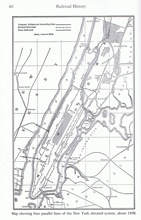 |
For reference, a map of the NY Elevated Railway system
ca. 1890 follows. SOURCE: Railroad History, Vol. 162, 1990, pg 69, 162 and as indicated on the photos |
|
|
| Also See: Buried / Abandoned Trains Found Beneath NYC Streets Webpage |
|